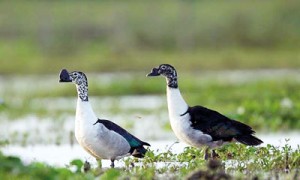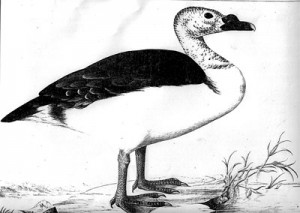The duck who caught the attention of Dutch Governor Gideon Loten

A recent spotting of a male and female Comb duck pair at Deberawewa, Tissamaharama. Pic by Palitha Anthony
The Comb duck, or Knob-billed duck (Sarkidiornis melanotos), has been observed by bird watchers and naturalists in Sri Lanka since June 2012. The unusual looking large duck has a worldwide distribution. It is found in tropical wetlands in Sub-Saharan Africa, Madagascar and South Asia from the Indian subcontinent to Laos and extreme southern China. It also occurs in continental South America south to the Paraguay River region in eastern Paraguay, south-eastern Brazil and the extreme northeast of Argentina, and as a vagrant in Trinidad.
The awareness of the Comb Duck’s presence in Sri Lanka stretches as far back over two and a half centuries. The species was first collected and recorded between 1752-1757 during the administration of the Dutch Governor Gideon Loten (1710-1789).
It was present in the neighbourhood of Colombo which was a part of the Maritime territories under Dutch rule.The original water colour and sketch of this duck formed a part of a portfolio of 154 illustrations in colour and was brought to England by Loten in 1859 and is now a part of the British Museum’s Natural History collection. The majority of the drawings were executed by the Sri Lankan artist Cornelius de Bevere (c.1722-1781).
Gideon Loten’s rise to eminence in England and Europe among the 18th century scientific world has been attributed to the stimulus generated by the drawings of Pieter Cornelis de Bevere. Loten was elected as a Fellow of the Royal Society, London in November 1760 and a large monument dedicated to him stands in the central aisle of Westminster Abbey.
The body of work that Loten amassed of this artist had serious impact on the leading naturalists and scientists in the latter half of the 18th century both in England and Europe. Hitherto, there were very few accurate illustrations or descriptions of the fauna of Sri Lanka available to the scientific world.
Among Loten’s associates and correspondents in Europe were the famous Swedish scientist Carl Von Linnaeus,(1707-1778) who promulgated the concept of binomial classification and Johann Reinhold Forster (1729-1798), the naturalist who accompanied Captain James Cook (1728-1779) on his second voyage around the world. In England, they were Sir Joseph Banks (1743-1820) (President- Royal Society London from 1765-1804), Sir Thomas Pennant F.R.S. (1720-1781), George Edwards.F.R.S. (1694-1773) and Peter Brown, the Danish naturalist.
Copies of de Bevere’s work were executed for Banks by his natural history artist Sydney Parkinson (c1745-1771) who both accompanied Captain Cook on his first voyage around the world. Engravings based on these drawings were also executed by Peter Mazell (c.1761-1797) for Pennant’s work, Peter Brown and Johann Reinhold Forster (1729-1798). At least five independent works were published in English and German containing copies of engravings based on de Bevere’s original sketches, which included Pennant, Edwards, Brown and Forster.
Loten made extensive notes evident from the inscriptions on the reverse of the drawings. Often the text accompanying the plates was extracted from these notes often based on information supplied by de Bevere and recorded by Loten. De Bevere was employed as a land surveyor by the Dutch East India Company during the administration of Gideon Loten, Dutch Governor of the Maritime territories 1752-1757, and was trained as a natural history artist under the latter’s supervision.
The first description of the Comb duck in science was by Johann Reinhold Forster in 1781 from an illustration based on an original painting by de Bevere from a specimen collected in Sri Lanka between 1752-57.The technical term describing or assigning a scientific name in the absence of an original specimen from an illustration is termed as icon type. It is ‘strictly, an illustration that formed the sole basis for a new species name’, not necessarily with a description unless the illustration remained unpublished. Nevertheless when a type specimen has not survived then their illustration whether published or not has great importance. In this respect, an original drawing is usually superior to a published one, hence the continued value of early drawings to taxonomy. Hence several of Pieter Cornelius de Bevere’s drawings now in the BM and other institutions in this respect are of primary importance to scientists and zoologists, as some species have become extinct like the Dodo or the passenger pigeon. Thomas Pennant writing in Indian Zoology (1791.page 1) commented,“That the species of Goose we describe is extremely common in Ceylon” which fact was further confirmed by Reinhold Forster who described it in his work Indische Zoologie (1781).
Almost a century later the British naturalist Edgar Leopold Layard (1824-1900)- noted that the bird was common in the Eastern Province (1856). Holdsworth also commented that it was reasonably well distributed. (P.Z.S.1872) as did Kelaart (1819-1860), Hume (1819-1912) and Parker (c.1879-1906).

The original of de Bevere’s painting that he did in Ceylon between 1752-1757
In the last quarter of the 19th century, Hugh Neville of the Ceylon Civil Service who amassed one of the largest collection of bird skins published his varied researches including natural history notes in the Taprobanian (1886)), quoting Parker commented, “According to my experience it is exceedingly shy, except when breeding; but a native once brought me four specimens which he said he had killed with one shot at the Giants Tank.”
He thought it was tolerably common though and breeds in the Mannar Province.
Colonel Vincent Legge (1841-1918) summing up all the literature over the century up to date in 1880 commented “The Comb Duck is more common than is generally supposed by those who have not visited the forests wilds of the Island(History of the Birds of Ceylon 1880-81 p1064).He suggested that the bird was distributed in the following localities: in the Vanni, (North Western Province), Anuradhapura District, Madawachiya, Mullaitivu, Toppur and south of Trin-comalee, Ampare and Irrukulam tank. Also found in Yala-and one of his correspondents, a Mr. Fisher found it breeding there.
But after 1900s the situation changed dramatically and the Comb duck was not encountered in their field work by any of the noted authors on ornithology – including Wait (1925), Whistler (1944), Phillips (1952) and Henry (1958).
But in 1960 the Comb duck’s presence was first noted by C.E. Norris and later in 1961 a confirmed fortuitous observation by the Game Ranger- Peter Jayawardene of a pair of female and male Comb ducks seen at Lahugalle (Eastern Province). The recent observations were virtually as Legge predicted in 1880 and so the search is on again to establish its presence.


